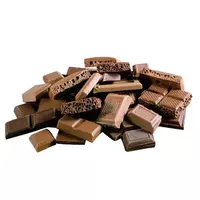Chocolate porous

Such a famous confectionery product as chocolate conquered the whole world many centuries ago. And the official history of chocolate began even earlier. The first chocolate was made by the indigenous people of Latin America. The first chocolate, or rather a chocolate drink, began to be made by Aztecs from cocoa beans. It is believed that cocoa beans began to be cultivated, as well as eaten from 1100 BC.
Proof of the fact that the ancient Aztecs were very respectful of cocoa beans can be served by the presence in the sacred pantheon of the gods of the people of the god Quetzalcoatl. Chocolate only reached Europe by the 16th century, when fearless Spanish conquistadors opened up new territory for their monarchy. Thanks to the famous Ernest Cortes, European foodies recognized chocolate and vanilla.
Currently, there are a fairly large number of varieties of chocolate, which differ in component ingredients, as well as in taste and consumer parameters. It is worth noting that professional confectioners know how to masterfully use all types of chocolate. Among the most popular and most widely used types of chocolate are the following: black, milk, as well as white chocolate.
A separate group distinguishes diabetic chocolate, which is intended for dietary nutrition of people with diabetes mellitus. In addition, there is porous chocolate - this is a type of confectionery that is obtained by processing the dessert mass. In the production of porous chocolate, the mass is poured in a special form, and then placed in vacuum boilers, which are held for 4 hours at a temperature of 40S.
Porous chocolate composition
As a result of temperature exposure, air bubbles begin to form in the vacuum medium. This is how the porous structure of the chocolate is formed. The composition of porous chocolate contains the same initial ingredients as in the manufacture of other types. Modern confectionery manufacturers offer consumers such basic types of porous chocolate as:
white porous chocolate;
milk porous chocolate;
black or bitter porous chocolate.
The composition of porous chocolate, however, as well as the calorie content of the finished confectionery product depends only on the type of product. The average caloric content of porous chocolate is 522 Kcal, which is per 100 grams of sweetness. The calorie content of the porous chocolate can be increased by using additional ingredients such as nuts, candied fruits or dried fruits in the product production process.
Porous chocolate was first prepared at the beginning of the 20th century in England. The first porous chocolate was called "Aero. " A year later, a new type of chocolate became in demand in most European countries. A bar of porous chocolate weighs about 75 grams, and a regular one weighs 100 grams. It is worth noting that porous chocolate differs from the usual one only in the method of production and the presence of bubbles or voids in the dessert mass structure.
porous chocolate 522 kCal
The energy value of porous chocolate (Ratio of proteins, fats, carbohydrates - ju):
Proteins: 5.7 g (~ 23 kCal)
Fats: 27.9 g (~ 251 kCal)
Carbohydrates: 61.4 g (~ 246 kCal)
Energy ratio (bj | y): 4% | 48% | 47%
 Español
Español Français
Français Português
Português Русский
Русский 简体中文
简体中文 繁體中文
繁體中文 日本語
日本語 한국어
한국어 العربية
العربية Türkçe
Türkçe Қазақ
Қазақ Deutsch
Deutsch Italiano
Italiano Українська
Українська
